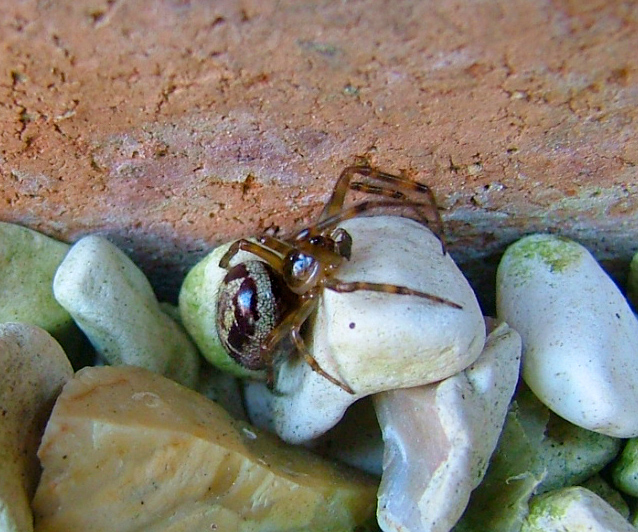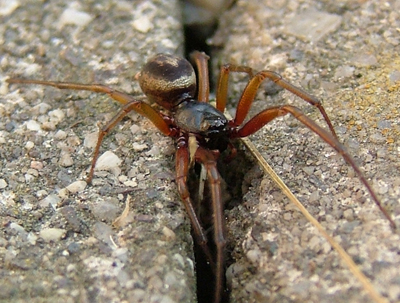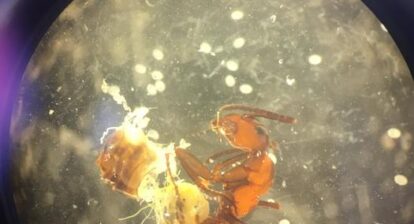Check out this video! Scientists at University of Galway have published the first record of a noble false widow spider (Steatoda nobilis) eating a pygmy shrew (species of tiny mammal protected in Ireland and the UK).
The noble false widow spider is a “is a globally invasive species with implications for public health and possibly for native ecosystems”, according to researchers. This study demonstrates the potentially negative impacts of the venomous spider.
Not only is this the first time a member of this family of spiders, called ‘Theridiidae,’ has been recorded preying on a shrew in Ireland or in Britain but it is also the first time any species of the half inch false widow spider have been observed preying on shrews anywhere in the world.

A mature adult female Steatoda nobilis on her web constructed on the outside of the first-floor window. Photo credit: Dawn Sturgess.
The study was published in Ecosphere, where the scientists stated: “The importance and novelty of this report are: (1) this is the third documented case of S. nobilis preying on a vertebrate in five years, suggesting that small vertebrates are likely to be a more frequent component of their diet than previously thought; (2) this is the first case of a Theridiidae spider preying on a shrew in Britain; and (3) this is the first case of predation on shrews by the genus Steatoda globally. Overall, S. nobilis fits the profile of a habitual vertebrate-eating spider.”
The research team at University of Galway’s Ryan Institute have been studying a diverse range of the species characteristics, such as its venom, their bite, ecology and behaviour, for the past seven years.
This extraordinary, and frankly scary, discovery was made by Dawn Sturgess, (one of the study authors), at a home in Chichester in West Sussex, Southern England. The small mammal was found entangled in the spider’s web that had been constructed outside of a bedroom window. The animal was later identified by its tooth as a pygmy shrew Sorex minutus.
“The remains of the shrew were nothing but fur, bones, and skin,”, said the researchers.

Male Noble False Widow Spider. Source: Wikimedia Brenda Avery Bravery
Initially the shrew was alive, however, the spider’s extremely potent neurotoxic venom started taking effect and the shrew became “increasingly incapacitated“. “The spider was observed hoisting the shrew upwards into the rafters where it wrapped it in silk and fed off its meal for three days.”
“There are currently 132 families of spiders representing 50,631 species (World Spider Catalog, 2022), and of these, members of at least 39 families are capable of preying on small vertebrates. The family most associated with vertebrate predation is Theridiidae, as per the scientists.”
Researchers at University of Galway’s Venom Lab had also previously provided video evidence of a false widow spider lifting a larger gecko off the ground using its sild threads as a pully, in a study published in 2021 in Food Webs. Evidently, this spider also used the same method to lift up the shrew higher up on the web.
Dr Michel Dugon, Head of the Venom Systems Lab, Ryan Institute, University of Galway and lead author of the study, said: “This observation demonstrates further that the noble false widow is perfectly adapted to take down large prey, combining potent venom, extremely strong silk, and complex hunting behaviour.”
Dr John Dunbar, Irish Research Council Post-Doctoral fellow, Venom Systems Lab, Ryan Institute, University of Galway, and senior author of the study said: “The noble false widow is a very intriguing spider, and we have much to learn about it still. We are very grateful to the members of the public who share their observations with us. This allows us to understand better how this invasive species may impact us and our environment.”
The scientists at University of Galway are encouraging members of the public to email them at falsewidow@universityofgalway.ie to report sightings of the noble false widow spider.
Read the full study in Ecosphere here: https://doi.org/10.1002/ecs2.4422







